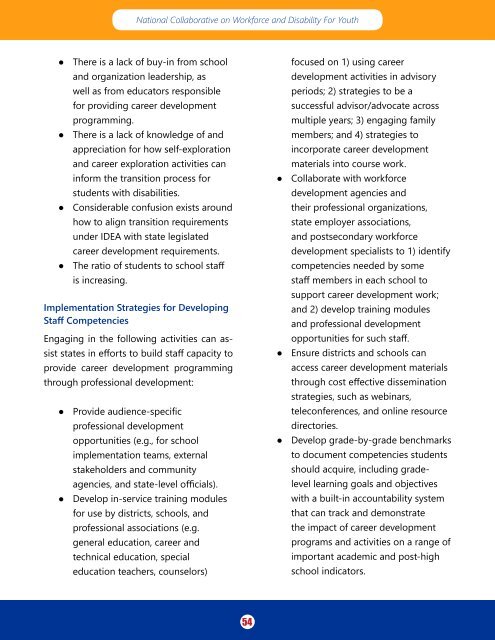Designing Statewide Strategies & Programs
DesigningStatewideCareerDevelopmentStrategiesProgramsPub_0
DesigningStatewideCareerDevelopmentStrategiesProgramsPub_0
Create successful ePaper yourself
Turn your PDF publications into a flip-book with our unique Google optimized e-Paper software.
National Collaborative on Workforce and Disability For Youth<br />
●●<br />
●●<br />
●●<br />
●●<br />
There is a lack of buy-in from school<br />
and organization leadership, as<br />
well as from educators responsible<br />
for providing career development<br />
programming.<br />
There is a lack of knowledge of and<br />
appreciation for how self-exploration<br />
and career exploration activities can<br />
inform the transition process for<br />
students with disabilities.<br />
Considerable confusion exists around<br />
how to align transition requirements<br />
under IDEA with state legislated<br />
career development requirements.<br />
The ratio of students to school staff<br />
is increasing.<br />
Implementation <strong>Strategies</strong> for Developing<br />
Staff Competencies<br />
Engaging in the following activities can assist<br />
states in efforts to build staff capacity to<br />
provide career development programming<br />
through professional development:<br />
●●<br />
●●<br />
Provide audience-specific<br />
professional development<br />
opportunities (e.g., for school<br />
implementation teams, external<br />
stakeholders and community<br />
agencies, and state-level officials).<br />
Develop in-service training modules<br />
for use by districts, schools, and<br />
professional associations (e.g.<br />
general education, career and<br />
technical education, special<br />
education teachers, counselors)<br />
●●<br />
●●<br />
●●<br />
focused on 1) using career<br />
development activities in advisory<br />
periods; 2) strategies to be a<br />
successful advisor/advocate across<br />
multiple years; 3) engaging family<br />
members; and 4) strategies to<br />
incorporate career development<br />
materials into course work.<br />
Collaborate with workforce<br />
development agencies and<br />
their professional organizations,<br />
state employer associations,<br />
and postsecondary workforce<br />
development specialists to 1) identify<br />
competencies needed by some<br />
staff members in each school to<br />
support career development work;<br />
and 2) develop training modules<br />
and professional development<br />
opportunities for such staff.<br />
Ensure districts and schools can<br />
access career development materials<br />
through cost effective dissemination<br />
strategies, such as webinars,<br />
teleconferences, and online resource<br />
directories.<br />
Develop grade-by-grade benchmarks<br />
to document competencies students<br />
should acquire, including gradelevel<br />
learning goals and objectives<br />
with a built-in accountability system<br />
that can track and demonstrate<br />
the impact of career development<br />
programs and activities on a range of<br />
important academic and post-high<br />
school indicators.<br />
54


